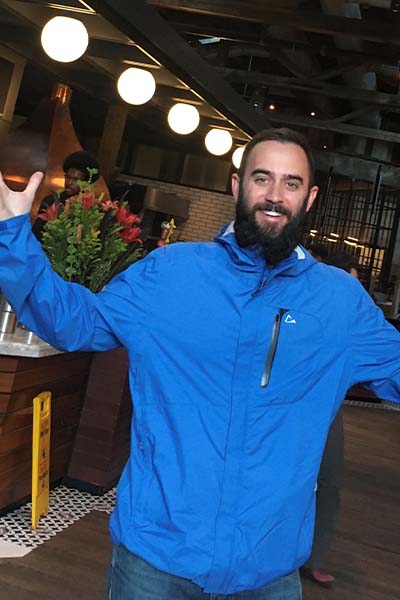Listen up marketers…we like to think we’re always making wise choices, but sometimes we stick our heads in the sand. When budget, staffing, or timing is tight, it’s soooooo tempting to cut corners and say to ourselves “it’s fine.”

Y’all…it’s really NOT fine, and deep down inside, you know it. Here are five ways tourism marketers often fool themselves, and how it comes back to bite them in the booty.
1) We can water down this BIG idea and still get BIG results.
The excitement and energy that accompanies a big idea is invigorating, infectious, and lasting. This is especially because the magnitude of the potential results makes us star-struck.
Here’s the rub, however. When – due to budget, operational challenges, timing, executive indecision, or whatever – that big idea gets watered down before implementation, often marketers are super bummed that the results aren’t the ones with which they originally fell in love. They conveniently “forget” that they dramatically pared down the idea, and never shed that infectious, lasting excitement they had at the start.
If this describes your organization, fear not…you’re not alone. I can’t tell you how many times clients have asked us for a BIG BOLD IDEA, which they love at first hearing. And by the time it comes back to us after several washings through their various committee discussions and lengthy decision-making processes, we don’t even recognize it. This phenomenon is quite common. In fact, it’s so common that we even have a term for it at Redpoint: vanillafication. That’s taking bright, colorful, tasty ideas…and wringing all the flavor out of them until they’re just vanilla.
Folks, there’s no harm and no shame in paring down ideas. Necessity (and the reality of your situation) often demands it. But if you pare down your ideas, you must proportionately pare down your expectation of results accordingly. Not doing so is just one way that tourism marketers often fool themselves…and then they’re disappointed.
2) It’s fine if we just replicate last year’s event as is.
No, it’s not. Whether it’s a trade or consumer event, whatever tourism thing you’re selling…it’s being sold to people. And people get desensitized so easily.
It’s essential that you add at least one new element to your annual events each year. It doesn’t have to be huge or cost a lot of money. Just something different than your audiences have experienced at that event before. It keeps the event fresh, makes an impression, and gives folks something to talk about…and maybe even post on social media or share in other ways.
Moreover, if you seek news coverage of the event, you actually need “news.” If the event is 100% the same as it was the last time they heard about it or attended, there’s literally nothing for them to cover. They need a nugget of something new to make their editorial coverage interesting and timely.
I know, I know. Tourism marketers are so busy and often stretched so thin that it’s a relief when you can finally put something on autopilot and not have to invest new creative energy or logistical planning into something that’s already “done.” Sorry, friends. This is yet another way tourism marketers often fool themselves.
3) We can wait to fix this website issue.
There are days when I feel like it would be easier to raise a child than properly maintain a website. Platforms evolve, things break, algorithms change, content gets stale… the list is endless.
The mission to keep everything current and in excellent working order is so relentless that it’s tempting to ignore some of the issues for a while. Like… “until I have the budget,” or “until I have the time,” or “until next year.”
Because of this, often tourism marketers fool themselves into thinking, “oh, it’s not that bad if that one part of the navigation is wrong,” or “it’s only a few broken links on pages people don’t use much,” or “yeah, the site is slow to load but it’s not that bad,” or – my personal favorite – “these photos aren’t the best, but they’re fine for now.”
This sort of ostrich mentality does your business grave damage. Why? Because it’s quietly and invisibly turning away potential customers…AND YOU DON’T EVEN HEAR ABOUT IT. Trust me, no one ever calls you up and says, “I was going to book with you, but your website annoyed me so much I decided against it.” They don’t do that…they just walk away.
Sure, if you look at your website analytics, you can see symptoms of this. But that’s easier to ignore (if you’re even looking…and many businesses, especially with DIY marketing, aren’t). Imagine if all those folks who walked away actually DID call you up and say that? You’d make fixing your website the highest priority instantly.
Your website is your virtual front door. Stop losing business because of it. On both desktop and mobile, it needs to be visually appealing AND fully functional. That means it’s fast, easy to navigate, informative, and current, with no broken links or wonky formatting. Users care about all of that, but as importantly…so do search engines.
Tip: here are six common website issues to look for on your site.
4) These photos are good enough.
I can’t tell you how many times tourism operators have handed me a brochure or a business card (sometimes even at a trade show!) and said, “This is us, but don’t look at the photos; they need to be updated.”
Here’s a story that puts that situation in perspective. During a website audit, we showed a hotel client that the highest number of people were leaving their site from their photo gallery page. Sweet lordy. A photo gallery page should inspire people to check dates and start the booking process, not leave the website.
Investing in a major photo shoot had seemed like something they couldn’t afford. But that audit showed them that they couldn’t afford NOT to do it.
Photos are an essential selling tool in tourism marketing. They can’t just be “good enough.” They have a job to do, which includes things like catching attention among cluttered social media feeds and capturing the imagination of website visitors. Ultimately, you want your photos to inspire action, whether it’s to read a caption, click a link, or inquire about booking.
Please don’t fool yourself when it comes to the quality of your photos. You will lose money because of it.
Note: for tips on this, see The Secret to a Great Tourism Photo and What Makes a Dramatic Tourism Marketing Photo.
5) It’s fine if no one else in our organization knows what marketing is doing.
In so many of the organizations we work with, marketing lives in a silo. And it’s sooo tempting to keep it that way. No scrutiny, no one chiming in with opinions, no questions about how budgets are being spent. We hear that a lot: “I just gotta keep my head down and churn out the marketing stuff.”
If this is you, hear me out. This is a major way in which tourism marketers often fool themselves. In the tourism industry, the relationship between marketing and all the other departments is crucial. Our product is experiential, and its delivery is dependent on operations, guest service, human resources, and more. It’s an ecosystem that needs to be in harmony at all times.
Because of this, EVERYONE needs to know what marketing is doing. Marketing is bringing in the guests who fuel the engine that delivers the experience. So, that engine needs to know what marketing is doing to make that happen…especially so they can live up to those promises.
Distribute a monthly update, make periodic presentations, even go door-to-door Erin Brockovich style and tell folks what’s happening. One business I know hosts a monthly “snack time,” at which they lure folks from other departments in with free snacks and share the upcoming marketing tactics while soliciting input for the future. Figure out whatever works for your organization’s culture and just do it.
~~~
Overall, it’s likely that time poverty and budget constraints are the two biggest culprits behind many of these unwise choices. So I get it… it’s not easy. But awareness is the first step toward change, so grab yourself a beverage and think about where YOU might be fooling yourself in your tourism marketing activities. Feel free to make that an adult beverage… you might need it. 😉
 get travel marketing tips
get travel marketing tips 




